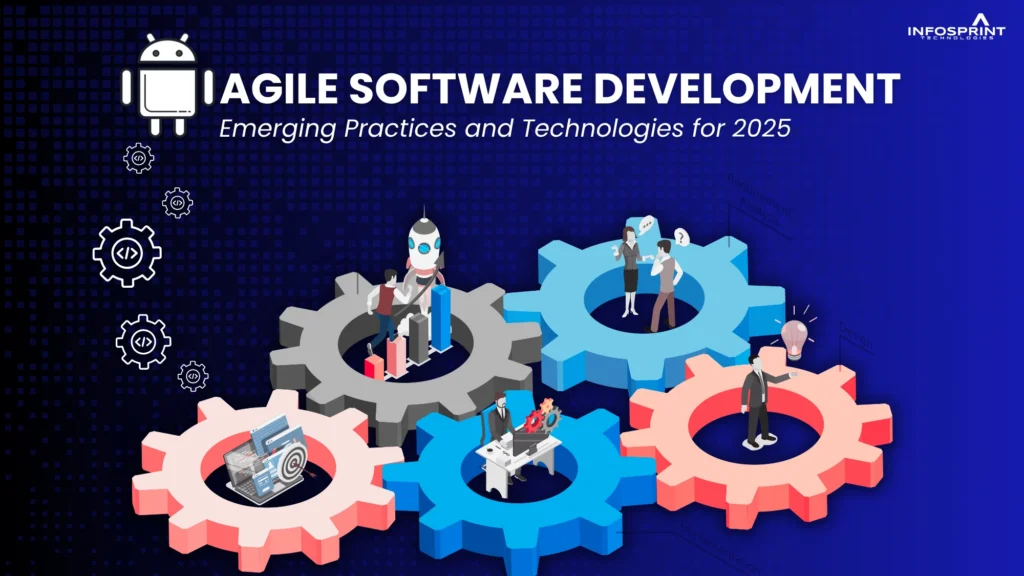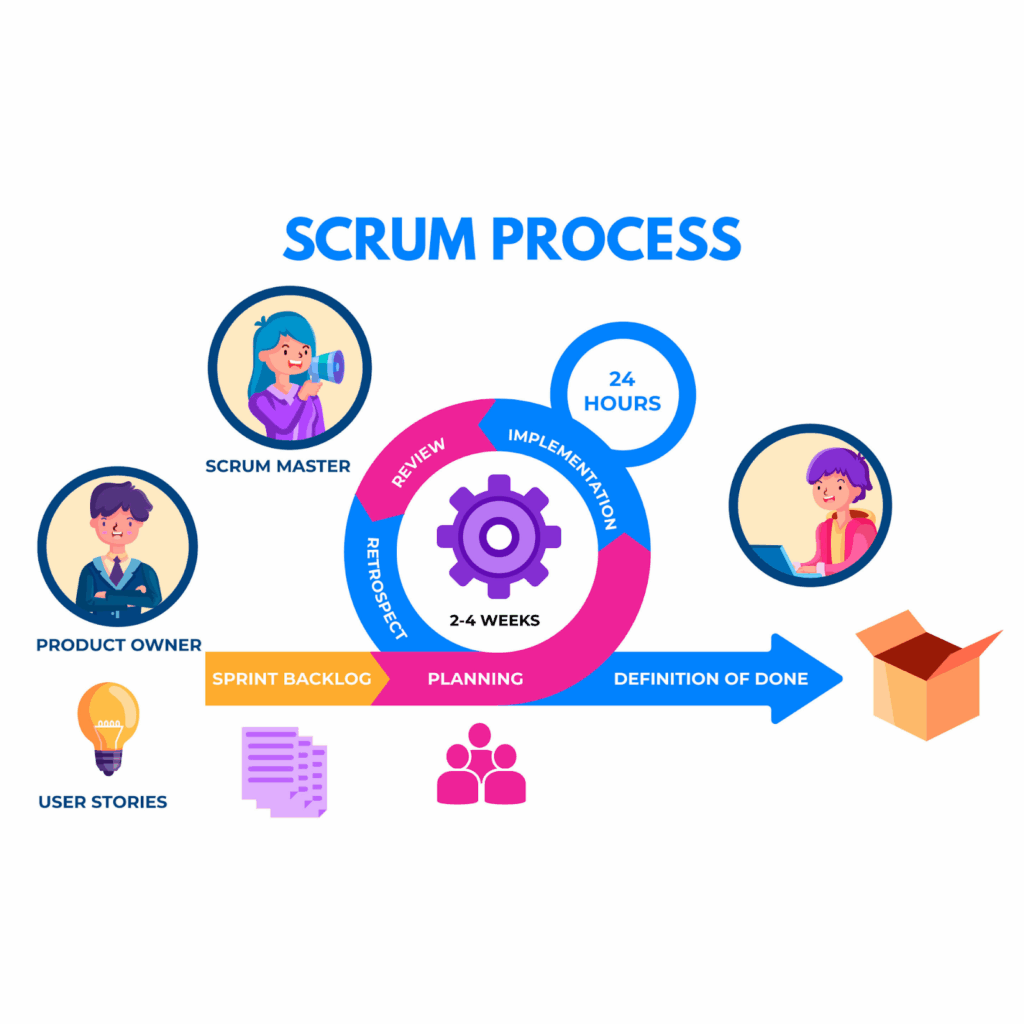The Future of Agile Software Development Emerging Practices and Technologies for 2025

The agile technique is a cutting-edge strategy for software development. It gives businesses a significant competitive edge and speeds up deployment and delivery. Future developments in automation and artificial intelligence will influence the makeup of the labor force and change how companies implement the agile technique.
As enterprises use Agile more and more, there are definite advantages. One of them is enhanced flexibility. Agile systems also give a company a competitive edge by improving its capacity to adapt to rapidly changing circumstances. The push for wider Adoption of this methodology reflects its potential to drive success.
In this blog, we will explore the most significant changes and technological advancements brought by agile and discuss the complexities of how these advancements will impact the software development industry.
What is Agile Software Development?
Agile is a form of software development that anticipates and brings flexibility to application development. This methodology handles portions of the application and distributes them gradually rather than delivering the complete application simultaneously.

Stay Updated with Emerging Technologies: Why?
Agile methodologies have revolutionized software development by emphasizing flexibility, collaboration, and continuous improvement to gain a competitive advantage and deliver high-quality applications. Infosprint Technologies, an IT consulting company with industry expertise, researches trends and adopts the latest technologies and practices to stay ahead.
Here are some of the advantages of staying updated with emerging practices and technologies in agile:
- Enhanced efficiency or productivity:
Adopt modern technologies to streamline processes, reduce manual labor, and increase efficiency. Stay updated with best practices to identify and implement efficient workflows.
- Improved product quality:
Adopting advanced techniques like continuous integration/continuous delivery (CI/DC) ensures high-quality code. You can identify security risks and proactively address them.
- Increased customer satisfaction:
Increased delivery speed and high product quality enhance customer satisfaction and gain their trust. Staying updated enables the teams to respond to the evolving markets and customer preferences.
- Competitive advantage:
Teams that embrace innovative technology can establish themselves as leaders in their field, attract top talent, and gain a competitive advantage. By being informed of industry trends, teams can predict possible problems and create mitigation methods.
- Fostering innovation:
Investigating cutting-edge methods and tools can inspire original thought and produce imaginative solutions. Keeping up to date encourages a culture of ongoing learning and development among team members.
Agile: A Decade of Success
In 2001, the agile methodology was presented to address the rigid schedule and operations in the software development industry. Since then, it has become widely used because of its flexibility, high quality, and speed of delivery. It enables teams to deliver incremental improvements more frequently while incorporating feedback throughout the development lifecycle.
Agile is now the accepted method for developing software. According to the 15th State of Agile Report (2021), over 95% of firms have used the Agile technique in one way or another. However, even with its broad acceptance, Agile has problems and restrictions.
Modernizing Software Development: Key Trends and Future Directions
- AI-driven agile practices:
AI is not a trend to look out for but rather to adopt. AI is revolutionizing the industries as we speak. We expect AI to enhance agile practices in 2025. Jira and Azure DevOps will use AI to allocate jobs automatically based on developer skill sets, historical performance, and project requirements. By examining past data, these systems can also forecast sprint results, providing teams with reasonable deadlines and goal-setting based on AI-driven forecasts. Testing frameworks driven by AI will increase, allowing for continuous testing through the development cycle. Testing gets more reliable and depends less on human intervention as AI learns from prior errors and flaws.
- Hyperautomation and DevOps integration
DevOps has a deep-rooted connection to agile success; its use is expected to increase by 2025. (CI/CD) will use automation to handle deployment, monitoring, and code-testing operations. Thanks to hyper-automation tools that decrease human intervention, teams can concentrate on higher-order tasks like architecture design and strategic decision-making. RPA tools manage repetitive daily functions within the agile framework, freeing developers, testers, and product owners to focus on more complex tasks.

- Agile and cloud-native development:
As cloud computing has grown, it has altered how software is deployed, developed, and maintained. By 2025, cloud-native development practices will be fully embedded into agile processes, making software scalable, flexible, and resilient. Microservices, which enable the autonomous development, testing, and implementation of tiny, modular parts of a more extensive system, will remain integral to agile development. Agile development cycles will accelerate serverless designs, which relieve developers of the infrastructure management burden.
- Agile governance and compliance
Agile frameworks require excellent governance and compliance as they become the norm in more businesses, particularly in regulated fields like healthcare, banking, and energy. By 2025, Agile technologies will automatically track audit trails, security procedures, and regulatory requirements, integrated with governance, risk, and compliance throughout development. Agile would ensure that projects follow industry-specific requirements and reduce manual overhead without impeding.
- AI-powered predictive analysis
Agile decision-making has always been data-driven, but AI-powered predictive analytics does it on a whole new scale. Teams will be able to predict project bottlenecks, delivery schedules, and resource requirements with remarkable precision by 2025, thanks to AI algorithms. AI will support real-time resource allocation analysis. Dynamic team modifications will be possible since predictive analytics will pinpoint the areas where more resources are required. This is crucial in Agile workplaces, where projects change quickly, and priorities can change anytime. AI algorithms will mine social media, user reviews, and other data sources to reveal information about the wants and habits of users.
Challenges and limitations of current Agile practices
While agile methodologies provide significant benefits, they are prone to challenges that organizations must navigate to bring out their full potential. Here are some challenges and limitations of agile practices:
- Scaling agile across large organizations:
Initially, agile was innovated for small organizations to coordinate cross-functional teams efficiently. Scaling agile across large organizations creates complexities, particularly in communication, coordination, and maintaining priorities, which organizations must navigate. Many organizations have invested in developing agile suitable for large-scale organizations, but it still poses a challenge for them.
- Agile in regulated industries:
Fields such as healthcare finance and government adhere to stringent regulations and demanding obligations. Agile methodologies: Frequent iteration and release conflict with the need for comprehensive documentation and a Rigorous auditing and validation requirement. In these sectors, Agile teams are often forced to decelerate their processes to address the criteria above. Doing so may cause them to lose the speed advantage that Agile typically offers.
Agile isn’t just about Following certain practices. It requires a culture change within organizations, which can be challenging. This may be particularly tough for organizations with hierarchical structures and those with traditional management styles.
Managers might need help to incorporate Agile’s emphasis on decentralized decision-making. Teams may also resist new working methods, including daily meetings and the lack of fixed long-term plans. This Resistance leads to the problem of cultural resistance to change.
- Inconsistent Agile Implementations:
Numerous organizations adopt Agile methodology in a patchwork style. This Inconsistency results in inconsistent implementations across teams. Some teams may closely follow Agile principles, while others may adopt only a few parts of the Agile methodology. This leads to fragmented processes and inefficiencies. For instance, some organizations maintain and treat Agile as a project management form. They Neglect its collaborative and iterative essence—such negligence results in “Agile in name only” (AINO).
- Challenges of Customer Collaboration:
A crucial aspect of Agile is intimate collaboration with clients. It is valid throughout the development process. Yet, in reality, maintaining this degree of engagement poses challenges. Consumers may not always be accessible. They may Lack the technical knowledge to give significant insights. All this could lead to misunderstandings or project deviations. Such issues may Only Come to light late in Project development, which can create resistance to product delivery.
- Speed Overemphasis:
Agile methodology centers on delivering functional software quickly. Sometimes, this comes at a cost. Long-term planning and Technical debt management often suffer. Teams confront pressure to Complete Features within sprints. Frequently, this results in shortcuts in areas like Documentation architecture and code quality. This accumulation of technical debt can slow down future development cycles.
The future of Agile is here.
Agile software development will keep changing as 2025 draws near, adjusting to new tools and methods. Thanks to developments in AI, automation, and cloud-native development, Agile has a bright future. However, the fundamental ideas of Agile—cooperation, customer-centricity, and flexibility—will never change, guaranteeing that it will stay the cornerstone of contemporary software development for many years to come. Agile will continue to be at the vanguard of digital innovation, assisting businesses in managing distributed teams and utilizing AI-driven solutions.
Related Posts

RPA automation strategies: Why RPA is essential for business growth in 2025

Still Stuck with Legacy Systems? Upgrade Your Business with Cloud RPA




